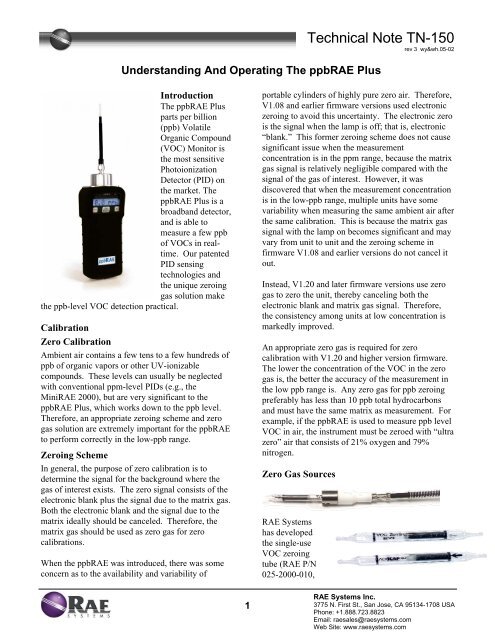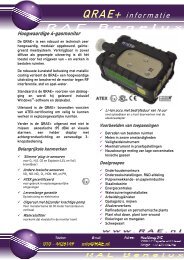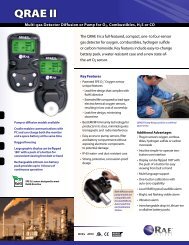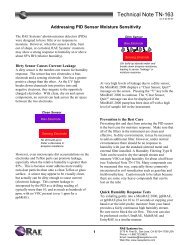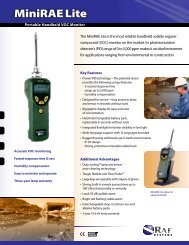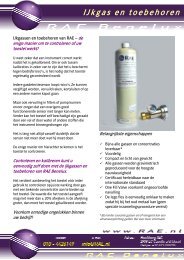PIDs As HazMat Response Tools
PIDs As HazMat Response Tools
PIDs As HazMat Response Tools
Create successful ePaper yourself
Turn your PDF publications into a flip-book with our unique Google optimized e-Paper software.
Technical Note TN-150<br />
rev 3 wy&wh.05-02<br />
Understanding And Operating The ppbRAE Plus<br />
Introduction<br />
The ppbRAE Plus<br />
parts per billion<br />
(ppb) Volatile<br />
Organic Compound<br />
(VOC) Monitor is<br />
the most sensitive<br />
Photoionization<br />
Detector (PID) on<br />
the market. The<br />
ppbRAE Plus is a<br />
broadband detector,<br />
and is able to<br />
measure a few ppb<br />
of VOCs in realtime.<br />
Our patented<br />
PID sensing<br />
technologies and<br />
the unique zeroing<br />
gas solution make<br />
the ppb-level VOC detection practical.<br />
Calibration<br />
Zero Calibration<br />
Ambient air contains a few tens to a few hundreds of<br />
ppb of organic vapors or other UV-ionizable<br />
compounds. These levels can usually be neglected<br />
with conventional ppm-level <strong>PIDs</strong> (e.g., the<br />
MiniRAE 2000), but are very significant to the<br />
ppbRAE Plus, which works down to the ppb level.<br />
Therefore, an appropriate zeroing scheme and zero<br />
gas solution are extremely important for the ppbRAE<br />
to perform correctly in the low-ppb range.<br />
Zeroing Scheme<br />
In general, the purpose of zero calibration is to<br />
determine the signal for the background where the<br />
gas of interest exists. The zero signal consists of the<br />
electronic blank plus the signal due to the matrix gas.<br />
Both the electronic blank and the signal due to the<br />
matrix ideally should be canceled. Therefore, the<br />
matrix gas should be used as zero gas for zero<br />
calibrations.<br />
When the ppbRAE was introduced, there was some<br />
concern as to the availability and variability of<br />
portable cylinders of highly pure zero air. Therefore,<br />
V1.08 and earlier firmware versions used electronic<br />
zeroing to avoid this uncertainty. The electronic zero<br />
is the signal when the lamp is off; that is, electronic<br />
“blank.” This former zeroing scheme does not cause<br />
significant issue when the measurement<br />
concentration is in the ppm range, because the matrix<br />
gas signal is relatively negligible compared with the<br />
signal of the gas of interest. However, it was<br />
discovered that when the measurement concentration<br />
is in the low-ppb range, multiple units have some<br />
variability when measuring the same ambient air after<br />
the same calibration. This is because the matrix gas<br />
signal with the lamp on becomes significant and may<br />
vary from unit to unit and the zeroing scheme in<br />
firmware V1.08 and earlier versions do not cancel it<br />
out.<br />
Instead, V1.20 and later firmware versions use zero<br />
gas to zero the unit, thereby canceling both the<br />
electronic blank and matrix gas signal. Therefore,<br />
the consistency among units at low concentration is<br />
markedly improved.<br />
An appropriate zero gas is required for zero<br />
calibration with V1.20 and higher version firmware.<br />
The lower the concentration of the VOC in the zero<br />
gas is, the better the accuracy of the measurement in<br />
the low ppb range is. Any zero gas for ppb zeroing<br />
preferably has less than 10 ppb total hydrocarbons<br />
and must have the same matrix as measurement. For<br />
example, if the ppbRAE is used to measure ppb level<br />
VOC in air, the instrument must be zeroed with “ultra<br />
zero” air that consists of 21% oxygen and 79%<br />
nitrogen.<br />
Zero Gas Sources<br />
RAE Systems<br />
has developed<br />
the single-use<br />
VOC zeroing<br />
tube (RAE P/N<br />
025-2000-010,<br />
1<br />
RAE Systems Inc.<br />
3775 N. First St., San Jose, CA 95134-1708 USA<br />
Phone: +1.888.723.8823<br />
Email: raesales@raesystems.com<br />
Web Site: www.raesystems.com
Technical Note TN-150<br />
rev 3 wy&wh.05-02<br />
as shown below) as the best and the most convenient<br />
provider of “ultra zero” air by purifying the ambient<br />
air running through it. Possible ppbRAE zero gas<br />
sources are listed below in order of preference:<br />
1. Single-use VOC zeroing tube (RAE Systems P/N<br />
025-2000-010).<br />
2. Large (>200 scf) laboratory ultra-zero air<br />
cylinder (
Technical Note TN-150<br />
rev 3 wy&wh.05-02<br />
Consistency Among Different Units<br />
Six ppbRAE Pluses are tested for measurement<br />
consistency. The units are zeroed with ambient air<br />
from a VOC zeroing tube and span calibrated with<br />
10.0 ppm isobutylene. The table below shows that at<br />
a isobutylene standard concentration below 200 ppb,<br />
into which the VOC concentration of the ambient air<br />
generally falls, a maximum variation of ±10% or ±15<br />
ppb, whichever is greater, can be achieved. Ambient<br />
air measurements have greater variability due to<br />
sample fluctuations. The sample probes of the units<br />
are located less than 10cm apart from each other.<br />
The continuous monitoring results through 50<br />
seconds (2 seconds per datum point) are averaged to<br />
represent the “true” response to the ambient air.<br />
With all the units considered, the average result of<br />
each unit presents a maximum variation less than<br />
±10% or ±20 ppb, whichever is greater. This<br />
verification shows that the consistency of ppbRAE<br />
Pluses using the new gas zero scheme (firmware<br />
V1.20 and higher version) is an improvement over<br />
the former electronic zero (firmware V1.08 and<br />
former versions).<br />
Gas type<br />
Maximum variation<br />
of 6 ppbRAEs<br />
Isobutylene<br />
standard<br />
200<br />
ppb ppb<br />
±10%<br />
or ±15 ±6%<br />
ppb<br />
Ambient<br />
air<br />
±10% or<br />
±20 ppb<br />
Sample Measurements<br />
The data shown in Figure 2 represent typical<br />
performance of ppbRAEs, and should not be treated<br />
as the specification.<br />
Figure 2.<br />
Reading, ppb<br />
20000<br />
18000<br />
16000<br />
14000<br />
12000<br />
10000<br />
8000<br />
6000<br />
4000<br />
2000<br />
0<br />
ppbRAE response to isobutylene<br />
8:38<br />
8:39<br />
8:40<br />
8:42<br />
8:43<br />
8:45<br />
8:46<br />
8:48<br />
8:49<br />
8:50<br />
8:52<br />
8:53<br />
8:55<br />
8:56<br />
8:58<br />
8:59<br />
9:00<br />
9:02<br />
9:03<br />
9:05<br />
9:06<br />
9:08<br />
Time, hh:mm<br />
Figure 2 shows the ppbRAE response to various<br />
concentrations of isobutylene in increasing and<br />
decreasing staircase steps of each concentration for<br />
two minutes. The response and recovery time of 90%<br />
changes is less than 5 seconds. All measurements are<br />
accurate and repeatable within the specification<br />
whether switching the gas from low to high<br />
concentration or vice versa.<br />
Figure 3 shows that the ppbRAE gives a linear<br />
response in the range of 10 ppb to 200 ppm. Various<br />
concentrations of isobutylene were diluted from the<br />
same setup and cylinder. It should be noted that if<br />
different cylinders were used, differences in<br />
background impurities from cylinder to cylinder<br />
could cause a significant error in this kind of ppb<br />
level measurement. Interconnecting tubing and<br />
Tedlar bags can also contribute significant error due<br />
to absorption at low ppb levels or release of<br />
plasticizers or previously adsorbed compounds. The<br />
user needs to be extremely cautious to avoid<br />
contamination when experimenting at the low ppb<br />
levels. An accurate and clean gas distribution and<br />
dilution system is recommended when performing<br />
this type of evaluation.<br />
3<br />
RAE Systems Inc.<br />
3775 N. First St., San Jose, CA 95134-1708 USA<br />
Phone: +1.888.723.8823<br />
Email: raesales@raesystems.com<br />
Web Site: www.raesystems.com
Technical Note TN-150<br />
rev 3 wy&wh.05-02<br />
Figure 3.<br />
Reading, ppb<br />
1000000<br />
100000<br />
10000<br />
1000<br />
100<br />
10<br />
ppbRAE linearity<br />
1<br />
1 10 100 1000 10000 100000 1000000<br />
Isobutylene, ppb<br />
Semi-volatile or Reactive Chemicals<br />
Heavy or reactive chemicals (e.g., hydrazine, phenol,<br />
methyl salicylate, dimethyl methylphosphonate, etc.)<br />
generally cause sample transferring loss due to the<br />
adsorption by the internal surface of the sample probe<br />
and the barrier (filters) in the sample probe. <strong>As</strong> a<br />
result, the response is slower or not visible for a<br />
period of time when the concentration of the<br />
chemical is low. Removing all the filters (including<br />
the mineral wool filter, the C-filter, and the stainless<br />
steel porous disk filter) is recommended for<br />
measuring heavy or reactive chemicals. In such<br />
cases, attention should also be paid to calibrate the<br />
unit in the same configuration with the filters<br />
removed.<br />
How to See Incremental Concentration<br />
Changes<br />
With a ppbRAE Plus, users have an option to read the<br />
real-time data as an incremental value from the<br />
background reading. When the “Cancel Background”<br />
feature is selected, the number shown on the ppbRAE<br />
Plus indicates the amount detected, minus the<br />
background. A superscript “+” flashes in the<br />
measurement display to indicate that the background<br />
is cancelled. The background can be reinstated when<br />
“Show Background” is activated. It should be noted<br />
that this feature of the “Cancel/Show Background”<br />
applies to the display only. The datalog function<br />
continues to record values that include the<br />
background regardless of whether it is shown in the<br />
instantaneous reading display. This feature allows the<br />
user to clearly see the incremental change of gas<br />
concentrations above the ambient background level.<br />
4<br />
RAE Systems Inc.<br />
3775 N. First St., San Jose, CA 95134-1708 USA<br />
Phone: +1.888.723.8823<br />
Email: raesales@raesystems.com<br />
Web Site: www.raesystems.com


